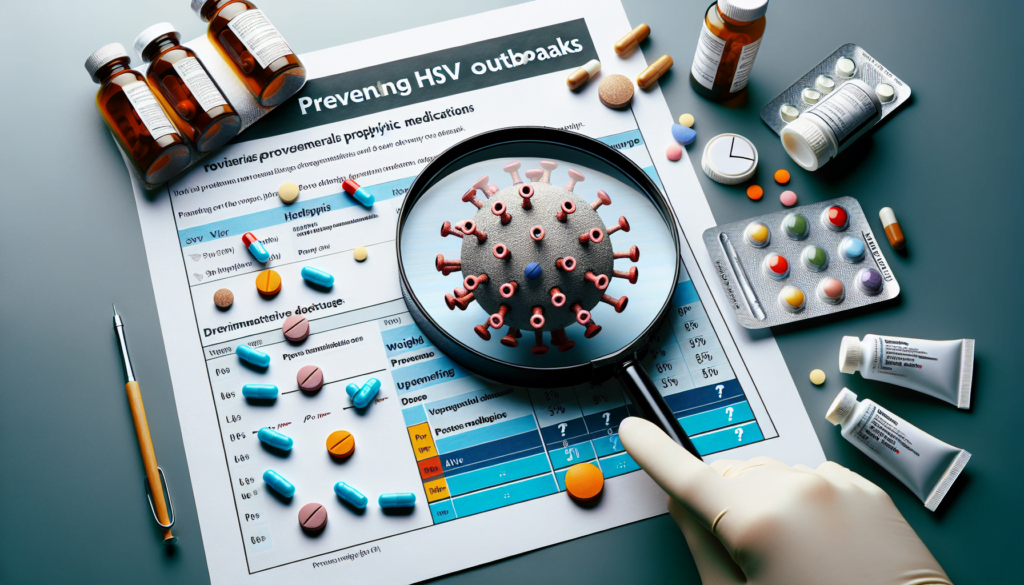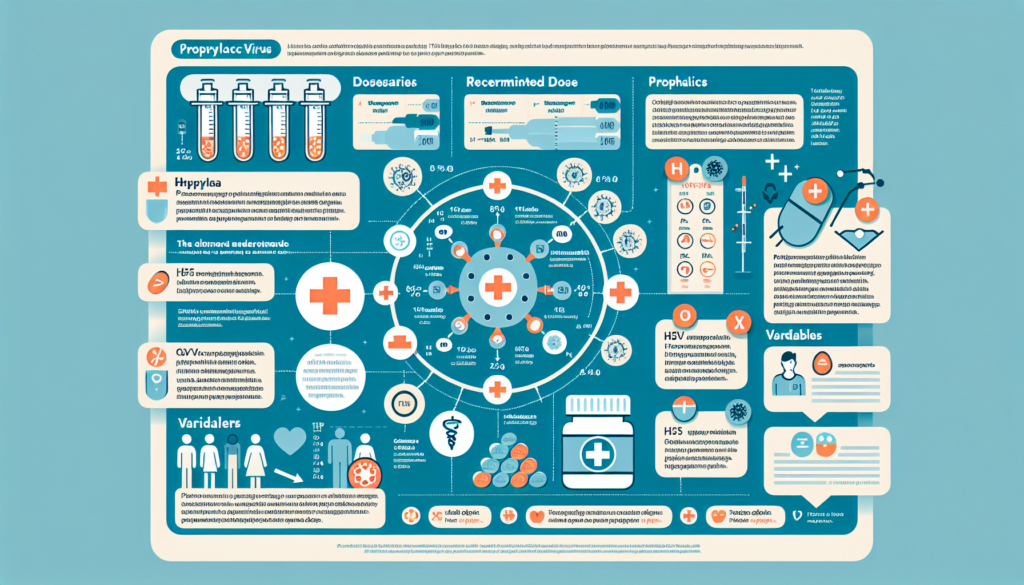Imagine having the power to prevent those bothersome herpes simplex outbreaks. Well, the good news is that there is a way, and it starts with understanding the herpes simplex prophylaxis dose. This article aims to provide you with a comprehensive overview of this essential information, allowing you to take control and make informed decisions about your health. From the science behind the dosage to the potential benefits and considerations, you’ll find everything you need to know right here. So, let’s dive into the world of herpes simplex prophylaxis dose and find out how it can positively impact your life.
Herpes Simplex Prophylaxis Dose


Overview of Herpes Simplex Prophylaxis
Herpes simplex virus (HSV) is a common viral infection that can cause cold sores or genital herpes. Prophylaxis refers to the use of medication to prevent the recurrence or outbreak of herpes simplex. It is an important aspect of managing the infection and reducing its transmission to others.
Types of Herpes Simplex
There are two types of herpes simplex virus: HSV-1 and HSV-2. HSV-1 is typically associated with oral herpes, which causes cold sores on or around the mouth. HSV-2, on the other hand, primarily causes genital herpes. Both types of herpes simplex can be transmitted through close contact with an infected person, even when there are no visible symptoms.
Factors Affecting Prophylaxis Dose
The prophylaxis dose for herpes simplex is determined based on various factors, including the individual patient’s age, immunocompromised status, frequency and severity of outbreaks, and the presence of concurrent medical conditions. These factors help healthcare providers determine the most appropriate and effective dose for each patient.
Common Prophylaxis Medications
There are several medications available for herpes simplex prophylaxis. These medications can be administered orally, topically, or intravenously, depending on the severity and location of the infection. The following are the common types of prophylaxis medications:
1. Oral Antiviral Medications
Acyclovir (Zovirax): Acyclovir is one of the most commonly prescribed antiviral medications for herpes simplex prophylaxis. It works by inhibiting the replication of the herpes virus, thereby reducing the frequency and severity of outbreaks.
Valacyclovir (Valtrex): Valacyclovir is another oral antiviral medication that is often prescribed for prophylaxis. It is a prodrug of acyclovir, meaning it is converted into acyclovir in the body. Valacyclovir has a higher bioavailability, meaning it is more efficiently absorbed by the body.
Famciclovir (Famvir): Famciclovir is another option for oral prophylaxis medication. It is converted into its active form, penciclovir, in the body. Like acyclovir and valacyclovir, famciclovir targets the replication of the herpes virus to reduce the frequency and severity of outbreaks.
2. Topical Antiviral Medications
Acyclovir Cream (Zovirax): Acyclovir cream is a topical medication that can be applied directly to the affected area of the skin or mucous membranes. It helps reduce the duration and severity of herpes simplex outbreaks.
Penciclovir Cream (Denavir): Penciclovir cream is another topical antiviral medication that can be used for prophylaxis. It works by inhibiting the replication of the herpes simplex virus, preventing the development of new lesions.
3. Intravenous Antiviral Medications
Acyclovir (Zovirax): Intravenous acyclovir may be prescribed in cases where the infection is severe or systemic. It is administered directly into the bloodstream to ensure a rapid and effective response against the herpes simplex virus.
Foscarnet (Foscavir): Foscarnet is another intravenous antiviral medication that can be used for prophylaxis in severe cases. It is typically reserved for patients who are resistant to or cannot tolerate other antiviral medications.
Recommended Doses for Herpes Simplex Prophylaxis
The recommended doses for herpes simplex prophylaxis vary depending on the specific medication, the treatment phase, and the individual patient’s characteristics. The following dosing guidelines are commonly used:
1. Initial Treatment Dose
The initial treatment dose is typically higher than the maintenance or long-term suppressive dose. It is aimed at rapidly bringing the infection under control and reducing symptoms. The exact dosage will be determined by the healthcare provider based on the severity of the infection and the patient’s individual needs.


2. Maintenance Dose
After the initial treatment phase, a maintenance dose is often prescribed to prevent the recurrence of herpes simplex outbreaks. This dose is usually lower than the initial treatment dose but is still effective in suppressing the virus and reducing the frequency of outbreaks.
3. Long-Term Suppressive Dose
In some cases, individuals who experience frequent or severe outbreaks may require long-term suppressive therapy. This involves taking a lower dose of the prophylaxis medication on an ongoing basis to prevent the reactivation and transmission of the herpes virus. Long-term suppressive therapy can significantly reduce the number and severity of outbreaks.
Factors Considered in Determining Prophylaxis Dose
When determining the appropriate prophylaxis dose for herpes simplex, healthcare providers consider various factors, including:
1. Patient Factors
Age: The age of the patient can influence the choice of medication and the recommended dosage.
Immunocompromised Status: Patients with compromised immune systems, such as those with HIV/AIDS or undergoing chemotherapy, may require a higher dose or different medication for prophylaxis.
2. Viral Factors
- Viral Load: The severity of the infection, as indicated by the viral load, can impact the choice and dosage of prophylaxis medication.
3. Disease Factors
Frequency of Outbreaks: Patients who experience frequent outbreaks may require a different dosing regimen compared to those with infrequent outbreaks.
Severity of Outbreaks: The severity of the outbreaks can also influence the choice and dosage of prophylaxis medication.
4. Medication Factors
- Medication Tolerability: Some individuals may experience adverse reactions or be unable to tolerate certain medications, requiring alternative options.
Potential Side Effects and Adverse Reactions
While herpes simplex prophylaxis medications are generally safe and well-tolerated, there are potential side effects and adverse reactions that should be considered. These can vary depending on the specific medication and the individual patient. It is important to discuss these potential side effects with a healthcare provider before starting prophylaxis treatment.
1. Common Side Effects
Common side effects of herpes simplex prophylaxis medications may include nausea, vomiting, diarrhea, headache, dizziness, and fatigue. These side effects are usually mild and temporary, and they often resolve on their own.

2. Serious Adverse Reactions
Although rare, serious adverse reactions can occur with certain medications. These may include severe allergic reactions, kidney dysfunction, and changes in blood cell counts. If any concerning symptoms develop or persist, it is important to seek medical attention promptly.
Importance of Follow-Up and Monitoring
Once initiating herpes simplex prophylaxis, it is crucial to follow up with regular medical appointments and monitoring. Healthcare providers will assess the effectiveness of the medication, monitor for side effects or adverse reactions, and adjust the dosing as necessary. Regular follow-up allows for ongoing management of the condition and ensures optimal treatment outcomes.
Conclusion
Herpes simplex prophylaxis plays a vital role in managing the infection and reducing the frequency and severity of outbreaks. The recommended prophylaxis dose varies depending on individual patient factors, viral factors, disease factors, and medication factors. Various medications, including oral, topical, and intravenous antiviral medications, are available for prophylaxis. It is important to work closely with a healthcare provider to determine the most appropriate prophylaxis dose and medication for your specific needs and to ensure regular follow-up and monitoring for optimal treatment outcomes.



